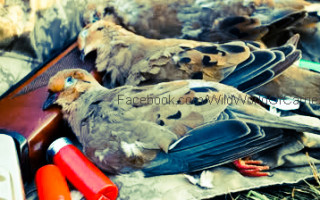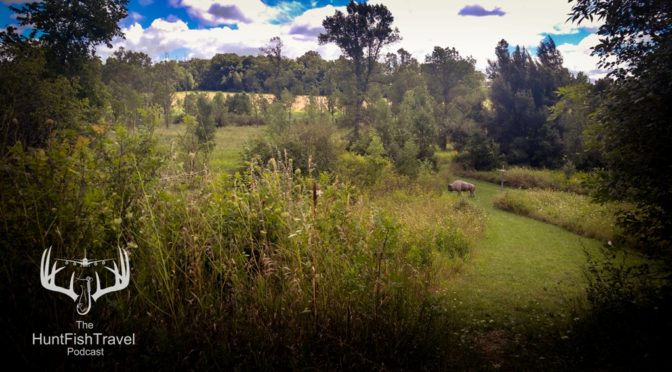 Hunting doves is not as popular as say, hunting deer. But anytime you can be out in the woods is time well managed. Doves are hunted in 40 states, with Michigan being the only Midwestern state to not have an established dove season. Approximately 41 million doves are harvested annually across the nation.
Hunting doves is not as popular as say, hunting deer. But anytime you can be out in the woods is time well managed. Doves are hunted in 40 states, with Michigan being the only Midwestern state to not have an established dove season. Approximately 41 million doves are harvested annually across the nation.
The population of the mourning dove in the continental US is estimated at around 350 million, making it one of the most plentiful birds in North America.
Make sure you know your local regulations, for example – many states require non toxic shot to be used.
Habits: 99.9% of a doves’ diet consists of seeds, and they almost always eat on bare ground (their little legs aren’t very strong). Sunflower seeds are their favorite but they also eat corn, wheat and oats. In addition they also eat the seeds of popular weeds such as foxtail and ragweed.
They seek out water after dawn and right before dusk. Wary little birds, they prefer muddy banks of creeks free of brush and plants and will often drink out of seepage puddles.
They love gravel sites as consuming bits of gravel and rock help their gizzards to grind up the seeds into a digestible format.
Doves can be loafers, if you find a sunflower field, a creek with a wide muddy bank and a gravel pit or sand bar nearby; chances are there are doves are nearby.
Scouting: Doves tend to move most within two hours after dawn and the two hours before dusk. Scouting a just harvested grain field is sure to yield some great results. Using binoculars watch for dove movement. If you only see one, give it some time, if more doves arrive, you’ve just found your dove hunting field.
Taking even just one day to scout feeder fields will yield big results. Again; doves are creatures of habits, but watching them you’ll be able to pattern them easily. Identify where they enter and exit the field, are they flying low through a natural tree funnel? Is there a high spot in the field?
While you are in the process of scouting, making your presence known is not totally a bad thing. Light pressure will get the birds moving, providing opportunity to pattern them. But don’t pressure them too much, more than a day or two and they’ll move locations completely.
Take note of doves sitting on power lines or dirt roads during the day, their feeding grounds will be nearby.
Best Time to Hunt: This will depend on how much scouting you’ve done and where you’ll be setting up. If you’re going to hunt their water source, dawn and dusk are your only real options, although they will occasionally hit a watering hole on a particularly hot day around noon. If you’re hunting a feeding site, 8am-11pm and 2pm-5pm (approximately) will be your best times.
Weapon: while there’s no perfect gun for hunting doves, obviously the only real choice is the shotgun in a 20, 16 or 12 gauge. Auto loaders are a plus as doves are small targets that move quickly providing three rapid shots. Federal Regulations require you have no more than three shells loaded at any given time while dove hunting.
Ammunition: Small shot size such as 7 ½, 8 or 9. The more pellets the better with these crafty little birds. My personal recommendation is a 1 ounce load in a size 8. Bring more ammunition than you think you’ll need. These fast flying birds have proven the fastest shooters. According to research studies, seasoned dove hunters actually harvest about three doves for every twenty-five shots.
Range: Allow the birds to come to you, by using decoys, scouting and timing techniques, you’ll be able to position yourself so they’ll come in at 25-35 yards.
Decoys: Place several decoys on open ground or along a fence line facing into the wind (doves take off and land into the wind) spacing them about a foot apart. Decoys make a bird more comfortable.
Camo: Blend perfectly with your surroundings. Doves have extremely sharp eyesight so using camo that matches your surroundings is key. And make sure to wrap your gun in camo tape if it has a standard finish. An organic blind is always better than a manufactured blind when it comes to dove hunting, they know what was there the day before, covering yourself in corn stalks or brush and setting up along woodlot edges will help ease their twitchy little fears.
The Shot: Remaining motionless is the biggest success factor. Doves are extremely spooky; the minute they realize you’re there they’ll be out of there. Sit so that you can bring your gun to your shoulder with the most minimal of movement. The second you start moving every eye will be on you and they’ll already be launching themselves into the air. Pull that gun tight to the shoulder, press that cheek to the stock, follow that bird in flight, aim and fire!
Practice: Trap and Skeet shooting are the best ways to practice for any kind of fast maneuvering bird hunting. Doves are surprisingly hard to hunt; they make for small targets and they are aerial acrobats, reaching flying speeds of around 40 mph and up to 60 mph when spooked. It’s not uncommon to have a bead on a dove only to have it drop three feet lower just as you’re squeezing the trigger.
Recovery: A dove’s feathers easily blend in with tall vegetation. It’s very easy to lose a dove when you’re shooting at multiple targets. The only surefire way to recover every single downed dove is to retrieve it immediately. If you have a dog, sending it out to get the dove while you take aim at the next one is a wonderful option. But if you’re hunting without a dog, your best bet is to go retrieve the bird and then try for bird number two.
Banded Doves: If you harvest a banded dove, please report it to the Bird Banding Lab Online Website or call 1-800-327-2263.
Managed Habitat: Check your local Department of Natural Resources website for information regarding habitat maintained specifically for doves.
~
Thanks for reading! If you enjoyed this post please share it with the world!
Don’t forget you can follow me on Twitter, Facebook or Google+.
While you’re here, check out the current and previous Wild World of CarrieZ episodes and don’t forget to leave a review on ITunes.
If you’d like to get immediate email notifications when a new article, contest or show is posted; enter your email address in the sign up box on the right.
Or you can sign up for the monthly newsletter sent out the 1st of each month covering all posts and podcasts episodes published the month before.
Thanks for your support!



